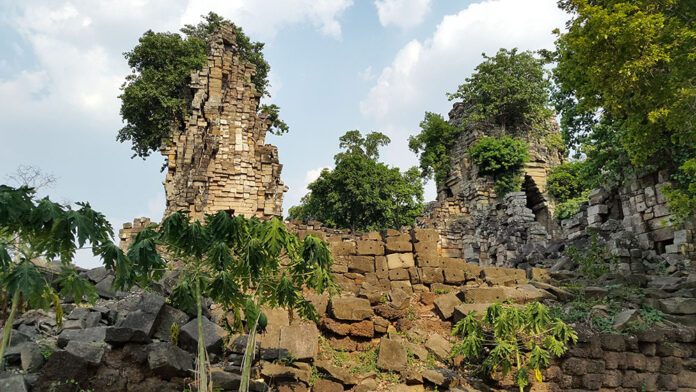
LONDON — An Australian archaeologist says he and colleagues have found evidence of previously undiscovered medieval urban and agricultural networks surrounding the ancient city of Angkor Wat.
Using high-tech lasers to scan the Cambodian jungle, Damian Evans and colleagues say they found traces of extensive networks surrounding the monumental stone temple complex at Angkor Wat. Evans said their findings could further our understanding of Khmer culture and throw into question traditional assumptions about the 15th-century decline of the empire.
Evans said a laser technology known as lidar was used to create precise maps of ancient networks that left only vague traces — invisible to the naked eye — in the landscape surrounding the temples.
“You could be standing in the middle of the forest looking at what appear to be some random lumps and bumps,” Evans said. “But they might actually be evidence of old excavated ponds or built-up roadways,” he explained. “All of these things left traces in the surface of the landscape that wouldn’t make sense to you without a more detailed picture.”
To obtain such details, Evans said his colleagues spent 90 hours in a helicopter directing laser scans into the jungle surrounding Angkor Wat. He said that the resulting images are so intricate “you can see objects lying next to a tiny anthill.”
The research was published Monday in the Journal of Archaeological Science. It was the result of a joint project including the French Institute of Asian Studies in Paris, the Cambodian national authority responsible for protecting Angkor Wat and the ministry of culture and fine arts.
For years, experts have assumed that the ancient Khmer civilization collapsed in the 15th century when invading Thai armies sacked Angkor Wat, forcing populations to relocate to southern Cambodia. But Evans said their laser maps showed no evidence of relocated, dense cities in the south and that it wasn’t clear there was any such mass migration.
Chanratana Chen, a Cambodian academic at the University of Sorbonne in Paris, said the new findings had changed his own perception of the Angkor Wat temple complex, which the Cambodian people commonly refer to as “the small city.” Chen was not involved in the new research.
“The new results (show) us that Cambodia was a much more advanced civilization than we thought, especially about the management plan of the city and irrigation system to improve agriculture in the area,” Chen wrote in an email. Among the most noteworthy discoveries Evans and colleagues had found were proof of medieval sandstone quarries and traces of a royal road between various temple complexes, he said.
Evans doubted tourists would soon be flocking to see the unremarkable “mounds in the ground” that the lasers had decoded at Angkor Wat, but said he and colleagues have now pinpointed sites that might be fruitful for further excavation.
He said it was likely there could be similar such discoveries elsewhere in Southeast Asia, possibly in Burma and even the Americas, where archaeologists might unearth more secrets about the remains left behind by the 6th-century Mayan Empire.
Story: Maria Cheng
















































